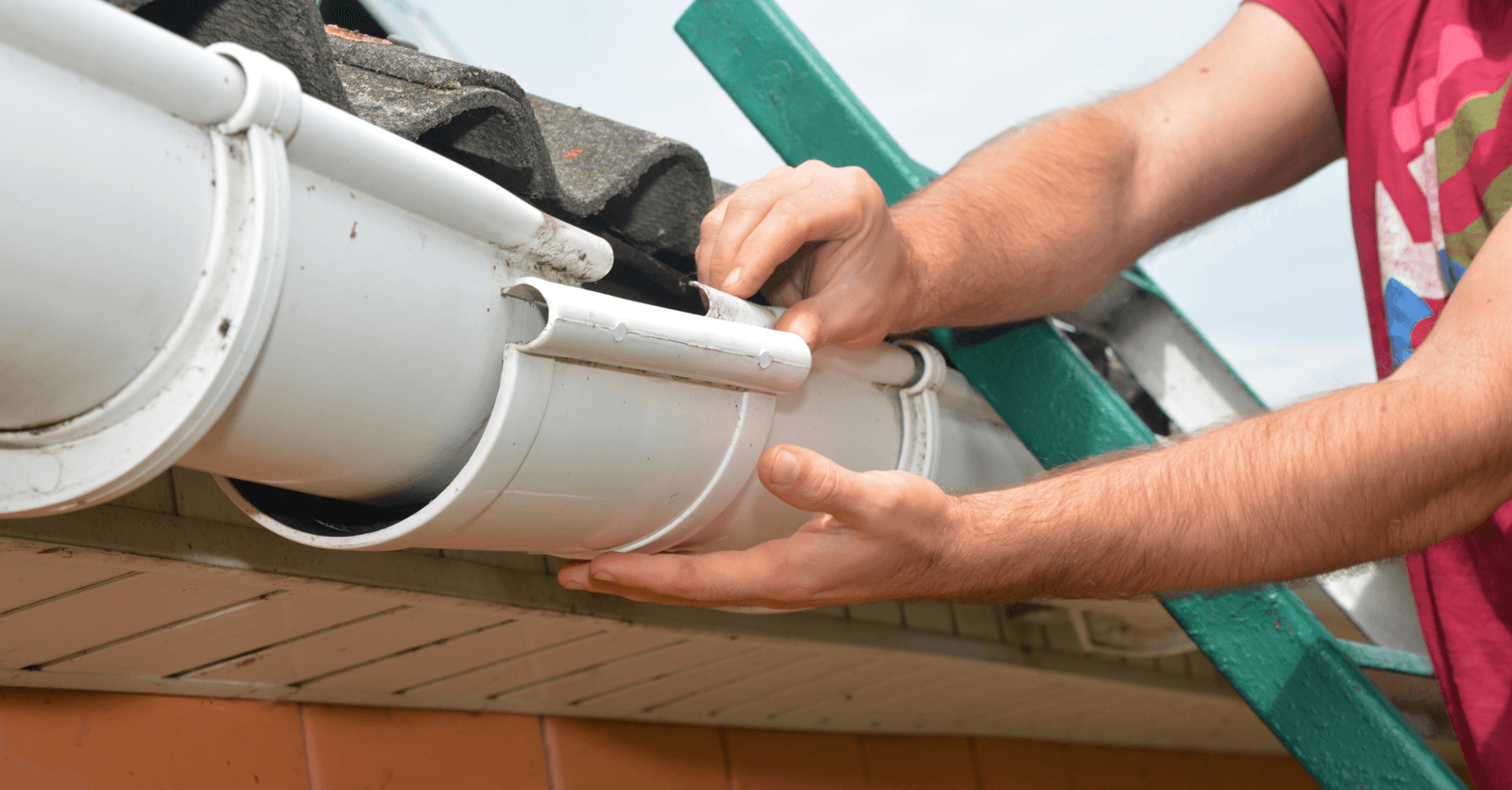
Rain gutters aren’t the most glamorous part of your home's exterior. They work hard to collect and carry rainwater away from the roof of your home but most homeowners pay little mind to these important structures. Gutters, also known as eavestroughs, work to keep basements or crawl spaces from collecting water. Therefore, they’re crucial in maintaining the structure and both the interior and exterior surfaces of your home.
If gutters break and water collects around your foundation, it’s likely that this liquid will find its way inside your home, causing damage and destruction wherever it goes. For this reason, gutters should be in proper condition. Thus, repairing a broken gutter as soon as the problem is detected is very important. Luckily, we’ve got the step-by-step guide to get this problem under control, making sure to preserve the foundation, exterior, and interior of your home.
Here’s how to fix a broken rain gutter
Source: Canva
PVC rain gutters: a note
Before starting, please note that PVC eavestroughs are nearly impossible to repair and will probably have to be completed replaced if they are damaged. Therefore, the instructions in this article mostly pertain to metal eavestroughs. Also worth noting is that throughout this article, we will be using both words to refer to the same thing.
Common rain gutter problems
Rain gutters work to collect and carry rainwater away from the foundation of your home. If they’re damaged, this water will instead run off your roof, erode the earth below, stain your siding and cause interior surface deterioration. Rain gutters in good working order take initial control of if water finds its way into your basement or crawlspace. As we briefly mentioned in our introduction, allowing water to sit around your foundation will cause hydrostatic pressure and lead water to find its way into your home. In some cases, this will cause interior mould and mildew growth and have detrimental effects on the health of your loved ones.
Let’s start by reviewing some of the common problems that occur with rain gutters. Holes can easily form along the body of the eavestrough and this defeats the purpose of them altogether. Leaky corner joints as well as further securing an eavestrough that’s pulled away or fallen from the house are two other commonly dealt with issues. As stated, fixing these problems as soon as they’re recognized will greatly improve the longevity of your home!
How to Patch Rain Gutter Holes

Source: Canva
Rain gutters develop holes for numerous reasons. Since they are in charge of collecting water, rust easily develops and this will eat through steel. In other instances, softer gutter materials, such as aluminum, can be easily damaged by outdoor debris flying into and puncturing the surface. This could be anything from branches and twigs to sharp objects. Patching a hole as soon as its detected is important because the hole will continue to grow larger as rainwater collects and falls through it.
To patch a hole, find roofing cement alongside a metal-repair patch. Make sure the one you choose is much larger than the damaged area. Bear in mind that the patch material should match the gutter material, as working with two separate materials may cause electrolytic corrosion. This is when metal starts to deteriorate due to a reaction with the other material, only worsening the issue.
Begin this project by cleaning the gutters of debris and scraping off anything that has caked on with a putty knife or a specifically designed tool for cleaning rain gutters. Next, grab some work gloves made of a tough material and scrub the area where the hole has been found, using a stiff wire-bristle brush in a back and forwards motion. Finally, if any rust has accumulated, make sure to take care of this by cutting it out with aviation snips. Once the area is clean, patch the hole according to the manufacturer's instructions.
What to do about leaking joints
Over time, gutters collect plenty of heavy rain and this causes the joints between to weaken and fail. Even new gutters don’t necessarily come equipped with seamless corners for their downpour or downspout outlets. For this reason, gutters can easily leak and cause water to collect around the foundation of your home. First, check all gutter seals to find the culprit and then you can begin this repair project.
Once you’ve located the leaking seal, you should use a seal seamer to add strength to the joint. When you’re searching for a seal seamer, we’d recommend looking for one which is self-levelling. This is because a self-levelling seamer will last longer and make a smoother connection between joints. If you aren’t able to locate a sealant of this nature, apply a silicone-rubber caulking compound along the seams on both the inside and outside of gutters.
Before re-sealing joints, make sure that you’ve removed any old sealer. Next, completely dry the area you’ll be sealing, as water will damage the connection. Lastly, follow the manufacturer's instructions to apply sealant. Of course, pick a day to complete this project when rain isn’t in the forecast.
Water behind the gutter
Water finding its way behind your gutter means that the gutter has been installed without flashing, also known as a gutter apron. A gutter apron will tuck behind your shingles and as well as over the gutter. You can find these at home improvement or renovation stores, and they generally come in 10-foot long sections. A gutter apron is simple to install and will be fastened in place with sheet metal screws. Remember, if your gutters are made of steel, you’ll need to buy steel flashing as aluminum will corrode this material.
How to Secure a Gutter
First, check to see if your gutters have standing water in them, as this could point to a sag in the gutter themselves. As we mentioned, standing water will rust steel and damage aluminum. Most gutters are held in place by way of large spikes that pass through tubular sleeves. Sometimes weather conditions cause gutters to pull free, come loose or be pulled completely from the side of your home.
If the gutter is sagging, the repair job will likely come down to replacing the spike. Spikes aren’t as commonly used to secure the modern gutter, and nowadays homeowners are installing fascia hanger brackets to keep gutters in place.
The installation process can be completed by the novice DIYer, hook the bracket under the front lip of the gutter, and screw the other side into the fascia. If your gutters were originally secured by spikes, leave these in place as there will be visible holes otherwise.
Click here to learn more about cleaning your rain gutters.
To learn more about materials and their average prices, check out our Gutter installation cost guide.
Get 3 renovation quotes for your rain gutter repair project
RenoQuotes.com will put you in contact with 3 reliable contractors for your eavestrough repair project. Fill in the form on our homepage (it only takes a few minutes), and you will receive quotes from trusted professionals.
Dial 1-844 828-1588 to speak with one of our customer service representatives
Looking for something else?
Related articles
The latest industry news, interviews, technologies, and resources.

Editorial Team
•02 Aug 2024
The shed has come a long way since it’s modest days of being a wooden box that holds gardening materials. Modern sheds have developed to host a variety of functions, aside from keeping landscaping tools clean and dry. Now, a shed can be turned into backyard haven, home-away-from-home, or a retro space to live out your hobbies.

Editorial Team
•21 May 2025
Good indoor air quality in your home is essential for living well, especially if your family members have allergies. This is even truer if your windows stay closed for most of the year.

Editorial Team
•24 Mar 2025
Whether building a new home or taking on a large renovation project, the novice might have no idea where to begin. Most know that when taking on any home renovation, the potential for problems and things going awry is high; your expectations might not match the outcome.

Editorial Team
•11 Oct 2024
Lacking in the idea department when it comes to choosing tiles for your tiny bathroom? If you manage to do it right, it could look a lot more spacious than it actually is. How can you go about choosing the perfect, size-appropriate tile for a bathroom? What colours and patterns can make a room appear bigger? Every decision must be guided by the room’s square footage to maximize comfort and aesthetics.

Editorial Team
•07 Apr 2025
In this first episode of Between Bricks and Binders, we welcome Marie-France, founder of Les Filles de la Construction. She shares her journey from a first-time renovator to building a network that empowers homeowners with the right knowledge and tools for their renovation and construction projects. We discuss how to choose the right contractor, avoid costly mistakes, and navigate the complexities of a renovation with confidence. A must-listen for anyone planning a home project!